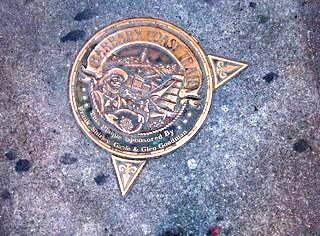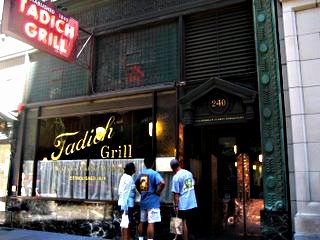Discover the Adventure
The San Francisco Gold Rush
The San Francisco Gold Rush is a Fascinating Story!
San Francisco played an important role in the California Gold Rush and the subsequent development of the state of California. It was in San Francisco that Sam Brannan first announced the now famous gold discovery to the world at large.
 Barbary Coast Trail Plaque; © BrokenSphere/Wikimedia Commons Barbary Coast Trail Plaque; © BrokenSphere/Wikimedia Commons |
First he walked the streets of San Francisco, shouting for all to hear, "Gold! Gold! Gold from the American River!"
Then he published a story about the discovery in his San Francisco newspaper, the California Star, which sent word of the discovery around the world!
And when you start to explore the role that San Francisco played in California's Gold Rush, you'll discover two "outdoor museums" - as I like to call them - disguised as self-guided walking tours.
Read on to find out how you can find and follow these paths to experience San Francisco's historic gold rush sites.
The San Francisco Gold Rush and
the Barbary Coast Trail
San Francisco's infamous Barbary Coast was named after the coast of North Africa because of its resemblance to that continent's piratical and lawless activities.
Populated by gamblers, criminals,
prostitutes, and con artists, it almost surpassed its namesake for evil activities.
Most notable was the practice of
shanghaiing - the often violent kidnap of inebriated sailors to man outward bound ships.
Today there's an historical walking tour named in honor of the Barbary Coast. Along it you'll find 20 historic sites, 5 history museums, historic sailing ships, lively pubs, outdoor cafes, and sweeping views!
Here are some of the sites that date from the San Francisco Gold Rush days that you won't want to miss:
- The Bank of Canton, though built in 1909, marks the spot where Samuel Brannan started the California Star, San Francisco's first newspaper and the one that first reported the discovery of gold in California.
- Commercial and Montgomery Streets - they're less than a block from what was once the Yerba Buena/San Francisco shoreline before that part of the Bay was filled in with sunken ships and abandoned household goods left behind by those who had run off to the goldfields.
- Jackson Square is surrounded by some of San Francisco's earliest architecture, lined as it is by Barbary Coast-era buildings. Before the Gold Rush and the filling in of parts of the Bay, this site was under water!
- The Old Barbary Coast was the largest West Coast port back in the day - this is another site that marks the old shoreline.
The Barbary Coast Trail begins at the Old U.S. Mint building in downtown
San Francisco, is just under four miles long, and is marked with 170
bronze medallions to point you in the right direction.
Follow the San Francisco Gold Rush Trail
The San Francisco Gold Rush Trail is a self-guided tour sponsored by The Gold Rush Trail Foundation and outlines 49 - a very significant number in Northern California history - historic sites.
It's conveniently divided into six smaller walks with sites of interest that are grouped by location.
Of special interest to those of us who are interested in walking in the footsteps of the 49ers and tracing the San Francisco Gold Rush:
- The original 1850 shoreline is marked by a sidewalk plaque near the bronze sculpture entitled The Mechanics, which is at the foot of Bush Street in the Commercial District.
- At 240 California Street you'll find Tadich Grill, the oldest restaurant - not only in San Francisco but in all of the West. It's been in continuous operation in one form or another since 1849 when it was a coffee stand! An Old San Francisco icon, it's a great place to eat - excellent food, friendly service, and huge portions! The waiters are dressed in white coats and black pants, and their menus are dated and printed daily, so you know the specials are fresh!
- The New World Market, San Francisco's original Produce District, stood near the current Embarcadero Center on Commercial and Leidesdorff Streets.
- In the Embarcadero District, a sidewalk plaque at Folsom and Steuart commemorates Sam Brannan's cry of "Gold! Gold! Gold from the American River!"
- The former site of the 1848 home of Yerba Buena's Alcalde - or Mayor - is now occupied by the Bank of America's International Headquarters building in the Financial District.
- The Wells Fargo Museum at California and Montgomery Streets has a collection of memorabilia and is free to the public.
- The Money of the American West Museum is within the Union Bank of California's basement. Among other Gold Rush-era artifacts, you'll find a cache of gold nuggets - in case you ever wondered what one should look for.
- The Levi Strauss Factory and Museum, at 250 Valencia Street in the Jackson Square District documents Levi's story of rags to riches - the pants he and his partner made resulted from his observations that the wool or linen pants of the day couldn't withstand the rigors of prospecting for gold, and soon became rags.
To learn more about the California Gold Rush and it's historic sites, follow the links in the Right-hand Column.
To explore more of The City by the Bay while you're in town, be sure to take a look at these pages:
- Discover San Francisco
For popular tourist attractions and insider secrets!
- San Francisco Attractions
Find out what there is to see and do!
- San Francisco Neighborhoods
Discover the Hidden Cities of San Francisco!
Please continue your exploration of what Northern California has to offer by using the Nav Bars in the left and right columns or by using the links at the bottom of the page.
Like what you're finding here at Discovering Northern California? Then please share with the Social Network of your choice.
And thanks for coming!
Related Pages
Bay Area
1906 Earthquake
Alameda County
Contra Costa County
Marin County
San Francisco
San Mateo County
Santa Clara County
Solano County
Related Pages
California Gold Rush
California Gold Rush
Discovery of Gold
Getting to California
Gold Rush Trail
Gold Rush Sites
Gold Panning
Related Pages
Hints & Tips
Beach Safety Tips
Best Kept Travel Secrets
Family Camping Tips
iPhone Travel Apps
Nude Beaches
Tide Pool Tips
Travel Sites We Love
Travel Tips
Whale Watching Tips
Wine Tasting Tips
Winter Driving Tips
Related Pages
Free Things To Do
Free in Big Sur
Free in Chico
Free in San Francisco
Free in Sonoma
Related Pages
Things To Do
Activity Village
Attractions
Beaches
Beer Lovers Delight
Burney Falls
Camping
Casa de Fruta
Day Trips
Gold Panning
Gold Rush Sites
Healdsburg
Historic Grass Valley
Lake Shasta Caverns
Lodi
Missions
Nevada City
RV Destinations
Ski Resorts
Tide Pool Tips
Travel Tips
Weekend Trips
Whale Watching
Wine Tasting
Related Pages
Insider Secrets
Best Kept Travel Secrets
Best Winter Whitewater
Boring Road? Nope
CA Admission Day
Climbing at Castle Rock
Crabbing Spots
Dream of Dreams
Fall in Eastern Sierras
Ghost Stories
Glass Beach
Great Stays, Low Pays
How to be a Valley Girl
Jade Beach
Lake Shasta Caverns
Lassen Volcanic SP
Lost Coast
Mono Lake
Moss Landing: Whales
New Clairvaux Abbey
Panning for Gold
Pygmy Forest
Mendo to Eureka
RV Destinations
SF Great Places to Eat
SF: More About Eating
SF Neighborhoods
SF Giants Baseball
Santa Cruz: Memories
Santa Cruz: Old Friends
Sonoma Cooking Class
Sonoma History
Sonoma Top Wine Stop
Tahoe: Discovery Trail
Underground Gardens
Yosemite: Family Hikes
Yosemite: High Country
YNP: Off the Beaten Path
Yosemite: Taft Point
Ziplines
